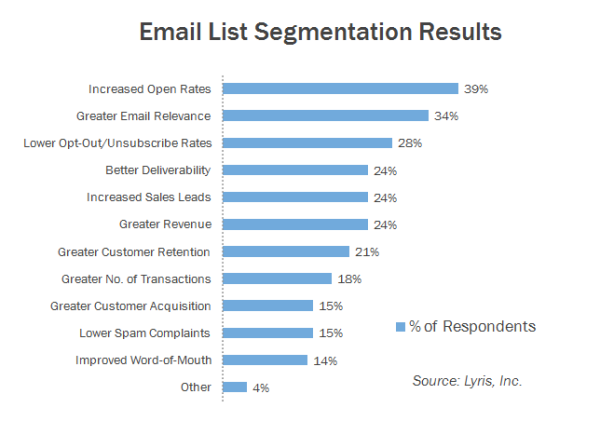 Eliza Gniadek
created
edited
Eliza Gniadek
created
edited
Why email list segmentation is a must
Back to list of articlesImagine that it’s your job to announce a presentation on a particular subject, like how to to take care of your complexion. When the day comes, you peek out from behind the stage and see a huge crowd of men and women of various ages. Some of them obviously take care of their faces, while others….not so much.
You start the presentation and almost immediately see some people get up and leave. What happened? Was it something you said?
The problem is most likely that you approached the subject too generally and didn’t address the needs of many people in the audience. After all, different parts of your audience were looking for different things - young and old, men and women, etc.
So what’s the solution? Creating groups with similar interests, needs and expectations.
The same idea applies to email marketing campaigns. You can’t send the same text to everyone in your mailing list and expect the message to relevant to everyone. Trying to appeal to everyone often means failing to appeal to anyone. This is why segmentation is key.
What is segmentation?
Segmentation is about dividing your subscriber list into smaller groups with similar characteristics. This means, for example, putting all new customers on the same mailing list or grouping together those who have recently made a purchase.
The stats show that segmentation works and helps you to get better results. According to DMA segmentation and targeted email campaigns can turbocharge both profits and ROI. If you’re not using segmentation, you’re leaving money on the table.
The benefits of segmentation
Dividing your subscriber list into smaller groups and sending messages that address their different needs and interests brings a variety of benefits, things like:
Personalized messages
First of all, you will be able to send personalized campaigns that better address the interests and needs of your subscribers. The better they are personalized, the better the chance that subscribers will be engaged and interested in your message.
Remember - segmentation without the use of personalization won’t bring the results you want. And that means more than just using a subscriber’s name in the subject line of the email. It means including content that is directly related to their demonstrated preferences. There is no one-size-fits-all message that will get the attention of everyone. Break your subscribers down in small groups and craft separate messages to appeal to the distinguishing factor that makes them different from others. Combining segmentation with personalization is a winning ticket. Just follow this example to see what I mean. Let’s say you create customer segments based on how active they are. You send different content to active subscribers than you do to others who haven’t opened any messages from you in a long time. Active subscribers might get something like an invitation to a frequent customer program or VIP status while inactive subscribers might receive a reactivation campaign with discounts or even a straightforward question asking them if they want to continue receiving messages from you or not. Read more about personalization here:
In short, segmentation is the necessary foundation for personalization, which in turn is the key to success. Every segment should have a dedicated strategy tailored to the interests of similar customers.
Database hygiene
Segmentation also helps to keep your mailing list in good order. This results from constant monitoring of subscriber statuses and better overall management of names and addresses. Put all addresses in one common list and then segment them to make them easier to manage. This also helps to eliminate the problem of duplicate addresses.
Turn leads into customers
Your subscribers are always at different points in the conversion process. Moving them further along requires sending the right message at the right time.
Segmentation helps you to identify distinct groups of subscribers and send them the appropriate kind of content. Lead scoring can then bring them to the final stage of the sales funnel. Learn more about it here:
Higher deliverability
Using segmentation and personalizing campaigns helps you to send subscribers the kind of content they want. That means that it increases the chances that your message will get opened. Email service providers can detect that messages sent from your domain get opened more often and that in turn improves your reputation as a sender. When the email service providers trust your domain, your messages are much more likely to land in inboxes rather than spam folders.
Better results
eMarketer asked marketers who use segmentation about the results they’ve achieved.
- 39% of them said segmentation gets higher open rates
- 28% notice fewer unsubscribes
- 24% said they got higher delivery rates and great sales results
Short summary
There is no downside to segmentation, only benefits. It brings greater results while helping o keep your email list in good order as it grows. It’s easy to do and skipping it means you’re not getting the results you should. And if all that isn’t enough to convince you, then think how far you’re going to fall behind the competition if they are using segmentation. You’ve got nothing to lose and everything to gain so get to work!


